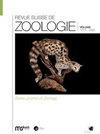日本小鼩鼱Dymecodon pilirostris实际类型位置的再思考
IF 0.5
4区 生物学
Q4 ZOOLOGY
引用次数: 0
摘要
在True(1886)对较小的日本鼩鼠Dymecodon pilirostris的原始描述中,它的类型位置被描述为“yeenosima,在日本Yeddo湾的入口处。”叶野岛是现在的叶野岛,一个小岛位于日本本州东部神奈川县面向太平洋的相模湾口,而不是东京湾(Yeddo湾)。由于其主要分布在山区的岩石地形中,因此其类型位置一直被认为是值得怀疑的。本文试图通过爱德华·s·莫尔斯带模式标本到美国的旅行,阐明模式定位与实际模式定位错误的原因。根据1878年标本从波士顿自然历史博物馆转移到国立自然历史博物馆之前,他第一次在日本的活动,我们可以看到,他大部分时间都呆在东京及其周边地区,这些地区位于毛毛螺分布范围之外。另一方面,他曾经去一个包括山区的地方收集无脊椎动物——本州东部枥木县日光市。如果是他自己获得的鼹鼠,那么类型地点很可能不是乙岛,而是日光。在此,我们建议根据建议76A,将毛螺D. pilirostris的类型地点由“Enoshima”改为“Nikko”。第76条第2款。本文章由计算机程序翻译,如有差异,请以英文原文为准。
Reconsideration of the actual type locality of the lesser Japanese shrew-mole, Dymecodon pilirostris
In the original description of the lesser Japanese shrew-mole, Dymecodon pilirostris, by True (1886), its type locality is described as “Yenosima, at the mouth of the Bay of Yeddo, Japan.” Yenoshima is the current Enoshima, a small island located not in Tokyo Bay (the Bay of Yeddo) but in the mouth of Sagami Bay facing the Pacific Ocean, Kanagawa Prefecture, in eastern Honshu, Japan. The type locality has been considered to be doubtful because Enoshima is not included in D. pilirostris' distribution, which mainly consists of rocky terrain in mountainous areas. In this paper, we tried to elucidate the cause of the error of the type locality and the actual type locality based on travels of Edward S. Morse who brought the type specimen to the United States. On the basis of his activities during his first stay in Japan before the relegation of the specimen from the Boston Museum of Natural History to the National Museum of Natural History in 1878, we can see that, on most days, he stayed in Tokyo and its neighboring areas, which lay outside the distribution of D. pilirostris. On the other hand, he once went to collect invertebrates in a location that is included in mountainous area – Nikko, Tochigi Prefecture, eastern Honshu. If he obtained the shrew-mole himself, the type locality is likely not Enoshima but Nikko. Here, we suggest that the type locality of D. pilirostris should be corrected from “Enoshima” to “Nikko”, according to the recommendation 76A.2 in the article 76 of ICZN.
求助全文
通过发布文献求助,成功后即可免费获取论文全文。
去求助
来源期刊

Revue Suisse de Zoologie
生物-动物学
CiteScore
1.30
自引率
12.50%
发文量
25
审稿时长
>12 weeks
期刊介绍:
The Revue suisse de Zoologie is a biannual journal published by the Geneva Museum and the Swiss Zoological Society. The Swiss Academy of Sciences and the City of Geneva provide financial support to the journal.
The Revue suisse de Zoologie publishes original results of zoological research, particularly in systematics and related fields.
 求助内容:
求助内容: 应助结果提醒方式:
应助结果提醒方式:


